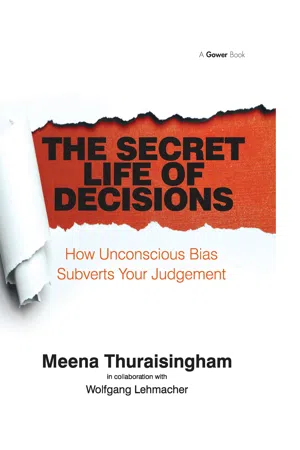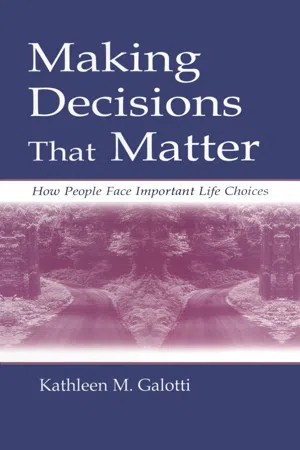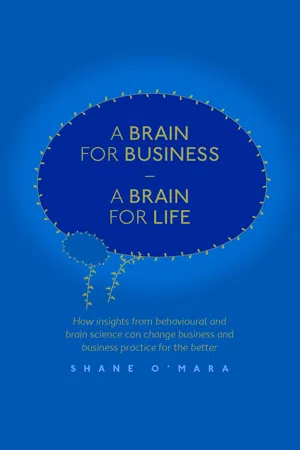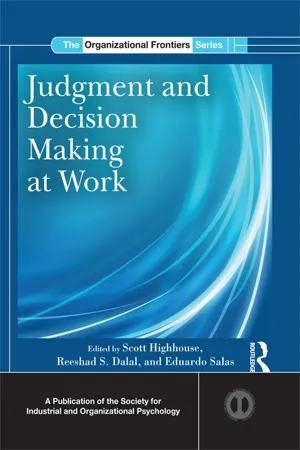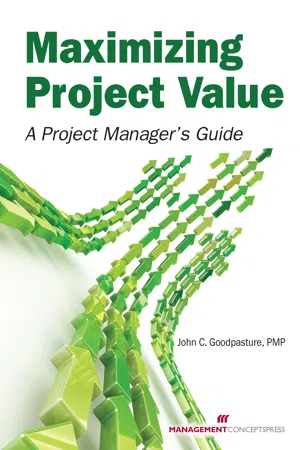Decision Making Biases
Decision making biases are systematic errors in judgment that can affect business decisions. These biases can lead to irrational choices and suboptimal outcomes. Common biases include confirmation bias, anchoring bias, and overconfidence bias, and being aware of these biases can help decision makers mitigate their impact.
8 Key excerpts on "Decision Making Biases"
- eBook - ePub
The Secret Life of Decisions
How Unconscious Bias Subverts Your Judgement
- Meena Thuraisingham(Author)
- 2017(Publication Date)
- Routledge(Publisher)
...This is not to say that intuitive thought is always inferior. As the following chapters will demonstrate, both are important for wise decisions and we refer to this as more mindful thinking, necessary for better decisions. Finally our cognitive habits are difficult to shake because associations and heuristics are ubiquitous in our thinking processes and in fact necessary for survival. Attempts to train people not to think representatively or overrely on intuition, associations and heuristics are mostly unsuccessful. We therefore have to take precautions against ourselves by investing self-knowledge, self-control and effort in our thinking. Part II of this book looks closely at the decision behaviour of business leaders, identifies the challenges of making good choices, judgements and decisions; recognises the risks that our own preferences, filters and biases represent and explores ways of modifying our decision behaviours in a way that helps lead the business, decision by decision, to enduring success. The Roots of Biased Thinking As business leaders, we face complex decisions where there is really no right or wrong and often on which much is riding. For example, which strategy to pursue, the market to get out of, the technology platform to invest in for the future, the people to retain or let go and so on. Figure 1.1 The process of making a decision Source: Adapted from Tourangeau, Rips & Rasinski, 2000 2 Irrespective of the type of decision a leader is confronted with, every decision process has effectively four parts as shown in the diagram (Figure 1.1) above: comprehension retrieval judgement response. At every stage, including comprehension, which itself is largely an interpretive action, the decision maker is adding layer upon layer of interpretation and therefore subjectivity. There is also no such thing as context-free decision making...
- Steven G. Rogelberg(Author)
- 2016(Publication Date)
- SAGE Publications, Inc(Publisher)
...Judgment and Decision-Making Process: Heuristics, Cognitive Biases, and Contextual Influences Judgment and Decision-Making Process: Heuristics, Cognitive Biases, and Contextual Influences Kristine M. Kuhn Kristine M. Kuhn Kuhn, Kristine M. 835 838 Judgment and Decision-Making Process: Heuristics, Cognitive Biases, and Contextual Influences Kristine M. Kuhn How people choose among jobs, how employers select and promote employees, how performance is evaluated and rewarded, and many other primary concerns of industrial and organizational (I-O) psychologists have human judgments and decisions at their core. The study of judgment and decision making is highly interdisciplinary and varied in its research approaches, but studying workplace decisions as decisions has significant potential to inform research and improve organizational outcomes. Heuristics and Biases A well-known behavioral decision making paradigm that has attracted attention from I-O psychologists is heuristics and biases, which was pioneered by the seminal work of cognitive psychologists Daniel Kahneman and Amos Tversky in the 1970s. This tradition proposes that observed decision behavior results from several cognitive heuristics, or rules of thumb, that generally produce reasonable and quick results but that can also lead to systematic patterns of error. Several heuristics have been identified and used to explain judgments in a wide variety of decision contexts...
- eBook - ePub
Introduction to Human Factors
Applying Psychology to Design
- Nancy J. Stone, Alex Chaparro, Joseph R. Keebler, Barbara S. Chaparro, Daniel S. McConnell(Authors)
- 2017(Publication Date)
- CRC Press(Publisher)
...Studies of decision-making reveal that decision-makers employ rules of thumb and systematic tendencies called heuristics and biases, respectively, that reduce the cognitive demands of the decision-making process. It is important to understand how heuristics and biases influence the outcomes of decision processes, as well as the impact of task and situational demands on decision outcomes. We also need to consider how the decision process changes as individuals gain experience, as evidence suggests that the decision-making processes of experts differ considerably from those of novices. This chapter reviews the role of biases, stress, expertise, and other factors on decision-making and explores the use of design of aids to support decision-making. 7.1 CHAPTER OBJECTIVES After reading this chapter, you should be able to: Describe the two major approaches to decision-making. Describe the different types of heuristics and decision biases that are characteristic of human decision-makers. Describe some of the attributes of experts and nonexpert decision-makers. Explain what decision aids are and how they can improve decision-making. 7.2 WHAT IS DECISION-MAKING AND WHY DO WE STUDY IT? Decision-making is generally defined as a task requiring an individual to choose among several alternatives with some uncertainty regarding which choice is the best one. Typically, this process is extended, requiring a choice to be made on the order of minutes or longer, using whatever information may be available. By understanding how individuals make decisions, what information they use, and what decision-related tasks they find difficult or perform poorly, the human factors expert can determine how to change the environment so individuals make better decisions. If you recall from Chapters 3 and 4, there are optimal ways to present information to individuals using displays...
- eBook - ePub
Middle Leadership Mastery
A toolkit for subject and pastoral leaders
- Adam Robbins(Author)
- 2021(Publication Date)
- Crown House Publishing(Publisher)
...What I would like to focus on is twofold: 1 The biases that affect the decisions we make. 2 The amount of time we put into each strategy compared to the value it adds to our strategic outcomes. 106 Biases we all suffer from We all suffer from biases. We can’t help it. Cognitive biases are the result of faulty thinking. This doesn’t mean that you are stupid. By faulty thinking, I mean that in order to cope with the large amount of information our brain has to process, we have naturally developed some shortcuts. These shortcuts lead to certain heuristics or ingrained assumptions that aren’t always helpful. Cognitive biases fall into two categories: 1 Memory related: You recall the past incorrectly and use it as the basis for future decisions. 2 Attention related: Your attention is a highly sought-after thing, and we are very selective about what we attend to. Even after reading this you will still suffer from biases and fallacies that will make you lean towards certain pieces of information more than others. Hopefully by being more aware of this you can notice biases in yourself and others and learn to acknowledge and counteract their influence when needed. There are hundreds of notable and named cognitive biases. We are going to focus on a small sample which are most relevant to making decisions under pressure. For each bias I will give an example and afterwards we will discuss ways of avoiding them. Egocentric bias: ‘The older I get, the better I was.’ This one is significant for middle leaders in schools. Egocentric bias occurs because we have too high an opinion of ourselves and our perspective. Essentially, this offers us a slightly rose-tinted view of our own history, implying that we were not quite as good as we think we were. This creeps into leaders’ decisions all the time. As they become further removed from the classroom, they find it harder to recall the truth about being a full-time teacher and remember it as being easier than it was...
- eBook - ePub
Making Decisions That Matter
How People Face Important Life Choices
- Kathleen M. Galotti(Author)
- 2005(Publication Date)
- Psychology Press(Publisher)
...Many times our ability to take in and interpret information stands us in very good stead. However, as the work of so many researchers has shown, there are a long list of ways that our natural way of approaching decisions isn’t sufficient to make rational decisions. Let us quickly review some of the heuristics and biases presented in chapter 3 : First, people frequently judge the frequency or probability of an event by the ease with which examples can be constructed or brought to mind (availability heuristic). They expect random processes to always generate results that appear random, and they pay more attention to vivid case studies than they do to base rate statistical information representing large numbers of cases (representativeness heuristic). The way a question or problem is phrased often dramatically affects people’s choices or preferences (framing effect). People perceive, interpret, and remember data that supports their initial ideas (confirmation bias) and see patterns of associations that may not truly be there, if the association makes sense in terms of their current thinking (illusory correlation). People are also reluctant to abandon a plan or course of action once they have invested resources in it (sunk cost effect). Another aspect of decision making found in many research studies concerns overconfidence—that is, a tendency to place too much trust in one’s own ability to gather enough information or to think of enough consequences. People are much more likely to have inappropriately high regard for their performance than they are to be inappropriately critical of it. The problem with overconfidence, of course, is that it keeps people from adopting strategies or tactics that might combat or address common decisional biases. What explains all these biases? Why aren’t people better at information processing? Cognitive psychologists from diverse theoretical camps agree: People have a limited capacity for doing cognitive tasks...
- eBook - ePub
A Brain for Business – A Brain for Life
How insights from behavioural and brain science can change business and business practice for the better
- Shane O'Mara(Author)
- 2017(Publication Date)
- Palgrave Macmillan(Publisher)
...Biases in decision-making may serve to reinforce affiliation or strength of the bonds within a tightly defined group, for example. Biases may also serve to punish behaviour that is seen to be transgressive—taking too much reward for too little effort (free-loading), for instance. In this case, there may even be a willingness to engage in costly punishment— to punish a member of one’s own group, or to punish an opposing group, even if there is an economic cost to oneself and to one’s group (Heinrich and colleagues 2006). The question posed by the group is simple: ‘what sort of a hit are we willing to take in order to teach the other lot a lesson?’ Both history and experiments show that humans are willing to take punishments in order to teach the other side a lesson—costly punishments that would not be prescribed by a purely rational calculus. The other side in the dispute may assume that there will be no costly punishment, as in believing that ‘they won’t impose trade sanctions on us. After all, they sell us a lot of cheese (or cars, or wine, or shoes—or whatever)’. But they can, and they will. A refusal to recognise in a negotiation that one side will act contrary to their own narrowly defined economic self-interest to ensure a broader political, legal and social lesson is learned is a very common mistake. Cognitive biases are a pervasive and universal aspect of human thinking. In essence, they are systematic biases in gathering information and in thinking that lead to a deviation from rationality calculations or even simply what is demonstrably ‘good and fair judgement’. The case study in the Chapter 1 of this book provides many examples of many cognitive biases, and we will discuss a few them below. There are huge numbers of biases—the Wikipedia entry for ‘ Cognitive Bias ’ lists more than 175 of them...
- eBook - ePub
- Scott Highhouse, Reeshad S. Dalal, Eduardo Salas, Scott Highhouse, Reeshad S. Dalal, Eduardo Salas(Authors)
- 2013(Publication Date)
- Routledge(Publisher)
...Studies over the 1960s, 1970s, and 1980s drew from economics, psychophysics, social psychology, and elsewhere to identify a profusion of shortcomings associated with everyday judgment and decision making. The list of cognitive biases includes ambiguity aversion, anchoring and adjustment, availability, base rate neglect, certainty effect, confirmation trap, conjunction fallacy, decoy effect, denominator neglect, dilution in prediction, duration neglect, endowment, evaluability weighting, focusing effect, framing effect, gambler’s fallacy, hindsight, honoring sunk costs, illusion of validity, illusory correlation, loss aversion, omission, outcome prejudice, overconfidence, phantom effect, planning fallacy, probability neglect, pseudodiagnosticity, representativeness, small-sample error, status quo effect, subadditivity, temporal discounting, and probably more. Moreover, explaining these phenomena to the general public has resulted in best-selling books by prominent JDM scholars (see Table 1.2). The success of these endeavors shows that: (a) JDM has permeated popular culture and our everyday language, and (b) JDM topics have considerable relevance to everyday life, including life at work...
- eBook - ePub
Maximizing Project Value
A Project Manager's Guide
- John Goodpasture(Author)
- 2013(Publication Date)
- Berrett-Koehler Publishers(Publisher)
...CHAPTER 5 JUDGMENT AND DECISION-MAKING AS VALUE DRIVERS Put your feet in the right place, and then stand firm. —Abraham Lincoln I f it were only true that stakeholders, customers, sponsors, and project teams were completely rational and efficient in their judgments and decision-making: • Rational in the sense that outcomes are predictable consequences of facts and other information applied consistently to an analytic decision-making process governed by a transparent policy, and • Efficient in the sense that all relevant information is available and objectively evaluated so that unbiased decisions are possible. Of course we know from experiments that the exclusively rational mind often can’t make up its mind and make a decision. The truly rational mind gets into a “do loop” of “if, then, else—but …” that constantly cycles. We call this “paralysis of analysis.” It takes a bit of emotion, belief, or passion—the not-rational reflex—to break the loop and actually make the decision. 1 And we know by experiment and observation that subliminal intuition and mood—largely influenced by experience and exposure to ideas—greatly affect decision-making. Research has shown that mood affects intuition and affects how the creative juices flow. Mood also affects our vigilance and inclination to avoid logical errors. 2 When we are in a good mood, our intuition is heightened; our creativity may be peaked; but we may be less vigilant about small errors. In fact, mood influences energy, which in turn influences receptivity to understanding available information. 3 (So just because this book is hard to read, don’t dismiss it out of hand!) Consequently, the judgments and decision-making of executives, stakeholders, and sponsors, as well as customers/users, are in part a consequence of many biases, moods, and experiences. We call this cognitive bias. Cognitive bias is a departure from the objectivity that a neutral third party would have, given access to all relevant facts...
